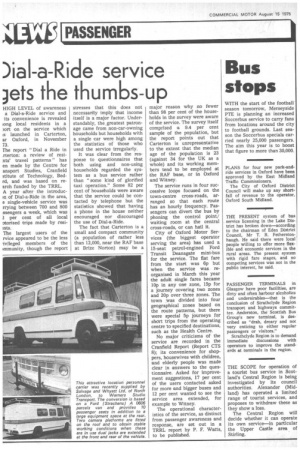)ial-a-Ride service jets the thumbs-up
Page 30

If you've noticed an error in this article please click here to report it so we can fix it.
HIGH LEVEL of awareness a Dial-a-Ride service and its convenience is revealed tong local residents in a )ort on the service which vs launched in Carterton, ar Oxford, in November 73.
The report "Dial a Ride in rterton: a review of resints' travel patterns" has en made by the Centre for ansport Studies, Cranfield stitute of Technology, Bedrd, and was based on rearch funded by the TRRL. A year after the introducin of Dial-a-Ride in the area, e single-vehicle service was rrying between 700 and 800 ssengers a week, which was 1 per cent of all local atorised trips made by resi The largest users of the rvice appeared to be the less ivileged members of the immunity, though the report stresses that this does not necessarily imply that income itself is a major factor. Understandably, the greatest patronage came from non-car-owning households but households with a single car were high among the statistics of those who used the service irregularly.
It was clear from the response to questionnaires that both using and non-using households regarded the system as a bus service rather than "some kind of glorified taxi operation." Some 82 per cent of households were aware that the service could be contacted by telephone but the statistics showed that having a phone in the house neither encouraged nor discouraged the use of Dial-a-Ride.
The fact that Carterton is a small and compact community (a population of rather less than 12,000, near the RAF base at Brize Norton) may be a major reason why no fewer than 98 per cent of the households in the survey were aware of the service. The survey itself comprised a 9.4 per cent sample of the population, but the report paints out that Carterton is unrepresentative to the extent that the median age of the population is 23 (against 34 for the UK as a whole) and its working members tend to be employed at the RAF base, or in Oxford and Witney.
The service runs in four successive loops focused on the town-centre cross-roads, arranged so that each route has an hourly frequency. Passengers can divert the bus by phoning the control point/ waiting room at the central cross-roads, or can hail it.
City of Oxford Motor Services (the biggest operator serving the area) has used a 15-seat petrol-engined Ford Transit Deansgate mini-bus for the service. The flat fare from the start was 6p but when the service was reorganised in March this year the adult single fares became lop in any one zone, 15p for a journey covering two zones and 20p over three zones. The town was divided into four geographical zones based on the route patterns, but there were special 5p journeys for short trips from the operating centre to specified destinations, such as the Health Centre.
No major criticisms of the service are recorded in the Cranfield Report (Report CTS 8); its convenience for shoppers, housewives with children, and elderly people was made clear in answers to the questionnaire. Asked for improvement suggestions, 17 per cent of the users contacted asked for more and bigger buses and 12 per cent wanted to see the service area extended, for example to Witney.
The operational characteristics of the service, as distinct from passenger awareness and response, are set out in a TRRL report by P. F. Watts, to be published.




































































































